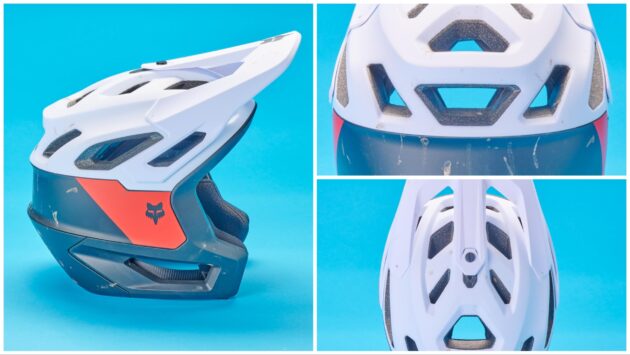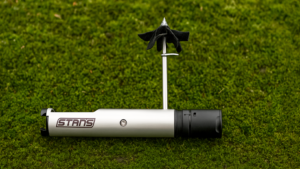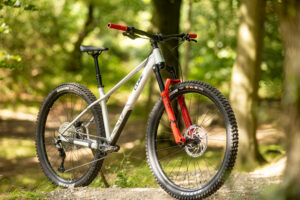The Fox Dropframe Pro is warm in winter, cool in summer, and brings extra coverage for gravity riding, but that additional protection comes at a price. fox-dropframe-pro-helmet-review
I’ve long been a fan of over-the-ears helmets, and the Fox Dropframe Pro is best I’ve tested, even if it makes me look like I’m delivering fast food
3/4 coverage enduro helmets are not a new thing – Giro and Troy Lee Designs marketed them for dual slalom and four-cross racing in the 00s, but they definitely seem to be trendy again. Rivals like the convertible Leatt MTB Helmet 3.0 and Giro Tyrant have been popularised by riders like Josh Bryceland and Josh Lewis in recent years. Fox offers two helmets in this style; the lighter Dropframe, and heftier Dropframe Pro.
– Short of time? Click here to skip to the verdict –
The former is like a Speedframe with extended sections over the ears (albeit with big cutouts), while the Dropframe Pro (tested here) is akin to a Proframe full-face with the chinbar chopped off. The weight difference is about 250-300g, so significant.

The Dropframe Pro is a more robust lid than the Dropframe, being effectively the full-face Proframe with a section chopped out of the chinbar.
Design and specifications
But the Dropframe Pro is also a significantly more advanced helmet, with an integrated dial-adjust retention system, adjustable peak, and Fidlock magnetic chinstrap buckle – all features missing from the Dropframe. Both get a Mips liner to help reduce rotational injuries, but it’s not the dual-skin Spherical design found on the (much) cheaper Giro Tyrant.

Fox has done a great job with the vents, channeling sufficient cooling airflow during the summer to avoid overheating.
While there’s a lot more real estate to the Dropframe Pro compared to its lighter sibling, it still gets eight frontal vents and seven exhaust vents, and these are mostly positioned over the scalp, so funnel cool air over the head and send heat and sweat out the back.
Structurally, the Dropframe Pro uses dual-density EPS foam that’s designed to absorb different impact velocities and spread the force across a larger surface area. It’s pretty common on the best mountain bike helmets now, but Fox has done a nice job of wrapping most of the edges and vulnerable areas to prevent the EPS from getting damaged.

The internal fit is excellent with several adjustment points for the retention system, different size pads, and an integrated dial at the back.
A little like some Specialized helmets, the internal retention device can be micro-adjusted by a BOA dial that’s built-in to the structure of the helmet. This means the dial is really easy to find at the back of the helmet. Fox also adds four height anchor points for the retention device as well as different size head and cheek pads to customise the fit. All pads are antimicrobial to help keep it fresher between washes.

I definitely felt better protected in the Dropframe Pro than an open-face lid, even though a full-face would be the more sensible choice for gravity riding.
The peak is longer than most open-face models – which suits the 3/4 design – and is adjustable for angle. There’s a GoPro mount in the box, and the flat underside of the visor also makes it well suited for sticky POV mounts.
Fidlock’s magnetic chin buckle makes it easy to fasten and release with one hand while on the move, and the open face design is easy to put on and take off.

Goggle straps nestle into that central channel, keeping them nice and stable.
Performance
Fox’s Dropframe Pro feels light and airy, with better airflow than the Giro Tyrant and more comfortable than the Leatt in 3/4 mode. In that sense it’s a better helmet for year-round use than either, as it adds a bit of extra warmth in the winter but never left me feeling overheated in testing. Fox seems to have dialled in the ventilation and channelling to really funnel cooling air over the scalp.
The retention system is quick and easy to dial-in, which, combined with the Fidlock magnetic buckle, is really handy for whipping the helmet off between runs on the uplift. And while there’s ample adjustment for achieving a glove-like fit, the Dropframe Pro is seriously stable without having to crank up the BOA dial. Some 3/4 helmets have given me headaches in the past as my head swells in hot weather, but the Fox left me with any pressure points or feeling crushed.
I’ve found it compatible with my favourite riding glasses (the 100% S3) as well as options from Madison, with plenty of room to slide the arms between the helmet and head. Goggles also play nicely, with the strap sitting in a recessed channel that wraps around the entire helmet.

The peak is adjustable and secured with a thumbscrew, while there’s also a GoPro mount option in the box.
After rattling around in my car for over a year, as well as being ridden through the depths of winter and taken on trips abroad, my original sample helmet is going strong with no signs of damage.
Verdict
For some people the 3/4 open-face helmet is a worst-of-both-worlds option, without the comprehensive protection of a full-face, but hit with the ventilation and weight penalty over an open-face. They are also more expensive, and won’t replace either an open-face or full-face in most riders’ armoury, making them a luxury that’s hard to justify. Those are all valid points, but there’s something about a 3/4 helmet that seems to suit riding a burly e-bike – maybe it’s the pizza delivery vibes! – where the extra protection coupled with exerting less effort on the bike (and generating less heat) makes them a great fit. I also love the extra warmth during the winter months. And of all the 3/4 helmets I’ve tested, the Fox Dropframe Pro is definitely the most comfortable and best ventilated. It also has a stack of cool features – such as the Fidlock buckle and integrated retention dial – that makes it really easy to live with.
















